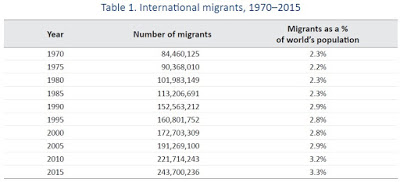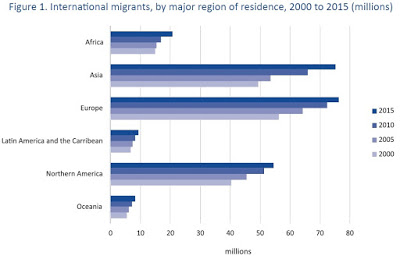International migration is one of the hot-button subjects everywhere.
The World Migration Report 2018 from the International Organization for Migration (the UN Migration Agency) provides a wealth of facts and background not just about the economics, which is my focus here, but also about regional aspects of migration, international frameworks governing migration, media coverage of migration, how potential migrants perceive their choices, and more.
Here’s a table showing total international migration over time. The absolute numbers have risen considerably, but the rise, when viewed as a share of global population, looks smaller.

And here’s a graph showing the destinations for migration by region:

Here’s a summing up of the overall patterns (with footnotes omitted for readability):
“The current global estimate is that there were around 244 million international migrants in the world in 2015, which equates to 3.3 per cent of the global population. A first important point to note is that this is a very small minority of the global population, meaning that remaining within one’s country of birth overwhelmingly remains the norm. The great majority of people in the world do not migrate across borders; much larger numbers migrate within countries (an estimated 740 million internal migrants in 20093). … Current data indicate that in 2016 there were 40.3 million internally displaced persons (IDPs) worldwide and 22.5 million refugees. Further, the total number of people estimated to have been displaced globally is the highest on record. …
“In regard to the distribution of international migrants by countries’ income group, about two thirds of international migrants resided in high-income economies in 2015 – around 157 million. This compares with 77 million foreign-born who resided in middle-income countries (about one third of the total migrant stock) and almost 9 million in low-income countries in the same year.”
As implied already, the main focus of the report is not on the economics of migration. However, it does sketch this brief overview of the potential benefits of migration (again, footnotes omitted):
“Migration can generate very large benefits for migrants, their families and countries of origin. The wages that migrants earn abroad can be many multiples of what they could earn doing similar jobs at home. For example, a study conducted in 2009 found that the ratio of wages earned by workers in the United States to wages earned by identical workers (with the same country of birth, years of schooling, age and sex, and rural/urban residence) abroad ranges from 15.45 (for workers born in Yemen) to 1.99 (workers born in the Dominican Republic), with a median ratio of 4.11. The wage differences and relative income gains from migration are largest for lower-skilled workers, whose international movements around the world are the most restricted. … Importantly, the beneficial effects of migration for migrants and their families go beyond economic impacts and frequently include improvements in other dimensions of human development, such as education and health. For example, according to a recent report by the World Bank, immigrants from the poorest countries, on average, experienced a 15-fold increase in income, a doubling of school enrolment rates, and a 16-fold reduction in child mortality after moving to a developed country,









Leave A Comment